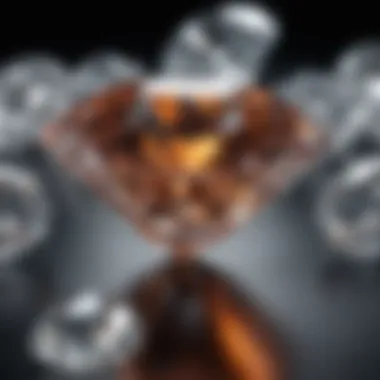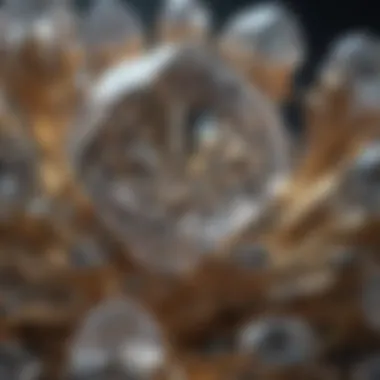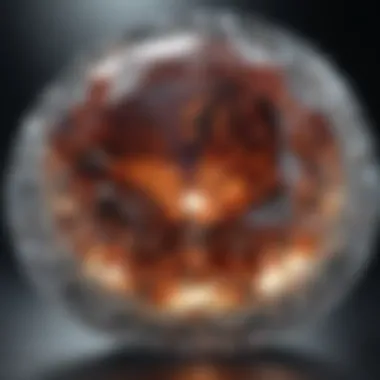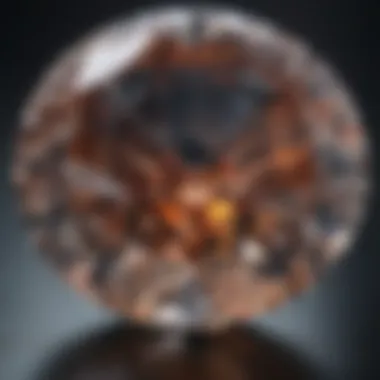Unveiling the True Essence: Diamonds as Exquisite Gemstones


Overview of Gemstones and Minerals
Diamonds, in their essence, bear a complex and fascinating history within the world of gemology and mineralogy. Their significance transcends mere aesthetic appeal, encompassing cultural, societal, and even mystical facets. From ancient times to the present day, diamonds have captivated individuals across civilizations, solidifying their position as one of the most sought-after gemstones in the world. The allure of diamonds extends beyond their physical properties, delving into their symbolic meanings, representations of power and love, and their unrivaled brilliance that sets them apart from all other gemstones.
Gemstone Formation and Properties
The journey of how diamonds come to exist in their radiant and coveted form begins deep within the Earth's mantle. Through immense pressure and temperatures, carbon atoms undergo a transformative process, crystallizing into diamonds over millions of years. These natural wonders boast unparalleled hardness, stemming from their unique atomic structure, which contributes to their durability and enduring beauty. The properties that define diamonds as gemstones go beyond their stunning visual appeal; they encompass attributes such as hardness, refractive index, dispersion, and clarity that collectively contribute to their allure and value.
The classification of diamonds based on color, hardness, and luster serves as a testament to their diverse range of qualities, from the colorless brilliance of white diamonds to the mesmerizing hues of fancy colored diamonds. Their ability to refract light with unrivaled fire and sparkle sets them apart as an exceptional category within the gemstone world, showcasing their splendor in various jewelry pieces and works of art.
Types of Gemstones
Within the realm of gemstones, diamonds reign supreme as precious gemstones, prized for their rarity, beauty, and enduring value. Contrasted with semi-precious gemstones, diamonds represent the pinnacle of luxury and excellence, symbolizing wealth, sophistication, and timeless elegance. While diamonds stand as a pinnacle, a vast array of other gemstones exists, ranging from the ever-popular sapphires and rubies to the exotic and rare varieties like alexandrite, tanzanite, and Paraiba tourmaline. Each gemstone holds its own unique charm and allure, captivating gemstone enthusiasts with their distinct colors, properties, and cultural significances.
Identifying and Evaluating Gemstones
The value and quality of gemstones are influenced by a myriad of factors that encompass their rarity, color intensity, clarity, cut precision, and carat weight. Evaluating gemstones requires a keen eye for detail and an understanding of gemological principles, with gemstone identification techniques ranging from visual inspection to advanced laboratory testing methods. Assessing gemstone quality involves grading various aspects of the stone, including its color saturation, presence of inclusions, optical phenomena, and overall aesthetic appeal. By considering these factors, gemstone enthusiasts and collectors can make informed decisions about the value and authenticity of gemstones in their possession.
Caring for Gemstones
Proper care and maintenance are essential to preserving the beauty and integrity of gemstones, including diamonds and other precious gems. Cleaning gemstones involves gentle methods that avoid harsh chemicals or abrasive techniques, safeguarding their brilliance and clarity. Storing gemstones properly ensures they remain free from damage and wear, with considerations such as humidity levels, light exposure, and protective settings playing a crucial role in maintaining gemstone longevity. Avoiding common mistakes in gemstone care, such as exposing them to extreme temperatures or chemicals, is paramount to safeguarding their beauty and value over time. Furthermore, specific gem types may require tailored preservation tips to address their unique characteristics and vulnerabilities, ensuring they retain their enchanting allure and luster for generations to come.
Introduction
In this article, we will embark on a journey to explore the intriguing topic of whether diamonds can be classified as gemstones. This exploration is vital in the realm of gemology and mineralogy, shedding light on the debate surrounding the classification of diamonds. By delving into the properties, formation, significance, and uses of diamonds, we aim to provide a comprehensive understanding that caters to gemstone enthusiasts, collectors, as well as individuals fascinated by the world of precious stones.
Definition of Gemstones
Characteristics of Gemstones
When discussing the characteristics of gemstones, we are faced with a multitude of unique features that set these precious stones apart. From their color, clarity, hardness, and brilliance to their rarity and durability, each characteristic plays a pivotal role in defining a gemstone. The distinct allure and timeless appeal of gemstones lie in their ability to effortlessly captivate and mesmerize admirers worldwide. These characteristics not only make gemstones highly sought after for ornamental purposes but also symbolize luxury, beauty, and sophistication. Throughout this article, we will delve deeper into these defining features and their significance in the context of diamonds.
Varieties of Gemstones
The world of gemstones is a vast and diverse realm, boasting a wide array of varieties that cater to different tastes and preferences. From diamonds and rubies to emeralds and sapphires, each gemstone variety possesses its unique allure and charm. These variations in color, cut, clarity, and carat weight contribute to the distinctiveness of each gemstone type. Exploring the varieties of gemstones offers a glimpse into the rich tapestry of the Earth's treasures and unveils the endless possibilities for adornment and appreciation. Throughout this article, we will explore the significance of different gemstone varieties and their relevance in the classification of diamonds.
Classification of Diamonds
Carbon-based Composition
At the core of a diamond's classification lies its carbon-based composition, a defining feature that sets it apart from other gemstones. The crystal lattice structure formed by carbon atoms under extreme pressure and temperature conditions gives diamonds their exceptional hardness and brilliance. This composition not only renders diamonds resistant to scratches but also allows them to disperse light in a unique way, resulting in the mesmerizing sparkle that has captivated humanity for centuries. As we delve into the classification of diamonds, understanding their carbon-based composition is essential to unraveling the true essence of these extraordinary gemstones.
Mohs Hardness Scale


The Mohs Hardness Scale serves as a vital tool in assessing the hardness of minerals and gemstones, with diamonds ranking at the very top with a hardness of 10. This exceptional hardness makes diamonds highly durable and ideal for everyday wear in jewelry. Their ability to withstand abrasion and maintain their luster over time positions diamonds as one of the most prized gemstones in the world. Exploring the significance of the Mohs Hardness Scale in classifying diamonds sheds light on their unique position among gemstones and highlights their exceptional physical properties.
Significance of Gemstones in History
Ancient Beliefs and Practices
Throughout history, gemstones have held a sacred place in various cultures and civilizations, revered for their mystical properties and symbolic meanings. From amulets and talismans to decorative adornments, gemstones played a crucial role in the spiritual and everyday lives of ancient peoples. The belief in the healing powers, divine connections, and protective qualities of gemstones underscored their significance in ancient beliefs and practices. By exploring these age-old traditions and rituals, we gain a deeper appreciation for the enduring legacy of gemstones in human history.
Royal and Historical Context
In royal and historical contexts, gemstones symbolized power, wealth, and status, adorning monarchs, nobles, and elite individuals throughout the ages. The opulence and grandeur associated with gemstones such as diamonds reflected the social hierarchy and cultural values of different civilizations. As emblems of prestige and influence, gemstones transcended mere ornamentation to become symbols of authority and magnificence. Understanding the royal and historical context of gemstones provides valuable insights into their enduring allure and cultural significance across diverse societies.
Physical Properties of Diamonds
The section on the 'Physical Properties of Diamonds' is a crucial component of this article as it dives deep into the foundational characteristics that define diamonds as gemstones. Diamonds are renowned for their exceptional physical attributes, which include color, clarity, cut, and carat weight, collectively known as the 4Cs. These properties not only determine a diamond's visual appeal but also its market value and quality.
Color and Clarity
The 4Cs of Diamonds
Exploring 'The 4Cs of Diamonds' is fundamental to understanding the worth and allure of these precious gemstones. The 4Cs consist of color, clarity, cut, and carat weight, with each factor playing a pivotal role in assessing a diamond's overall quality. Among them, color and clarity stand out as key determinants of a diamond's brilliance and value.
Diamond color refers to the presence or absence of color in a stone, with colorless diamonds being the most sought after due to their exceptional sparkle and purity. Clarity, on the other hand, measures the presence of internal flaws or blemishes within a diamond, affecting its transparency and brilliance. By assessing the 4Cs, gemologists and buyers can evaluate a diamond's uniqueness and determine its beauty and investment value.
Diamond Grading
Delving into 'Diamond Grading' unveils the standardized process used to evaluate and categorize diamonds based on the 4Cs. Industry experts meticulously analyze diamonds under specialized lighting to assess their color, clarity, cut, and carat weight, assigning them a grade that reflects their quality and value. Diamond grading laboratories such as the GIA (Gemological Institute of America) provide certificates that detail a diamond's attributes, serving as essential documentation for buyers and sellers.
The systematic grading of diamonds ensures transparency and consistency in the evaluation of these gems, guiding consumers in making informed purchasing decisions. By understanding diamond grading, individuals can navigate the market with confidence and select diamonds that align with their preferences and budget.
Crystal Structure
Cubic Lattice
The 'Cubic Lattice' is a distinctive feature of diamond crystal structure, characterized by a symmetrical three-dimensional arrangement of carbon atoms bonded together. This unique lattice configuration endows diamonds with exceptional hardness and durability, making them ideal for use in jewelry and industrial applications.
Diamonds' cubic lattice structure results in unparalleled optical properties, allowing light to refract and reflect within the stone, creating the renowned fire and brilliance that diamonds are admired for. This structural integrity not only enhances a diamond's beauty but also contributes to its resilience against wear and damage.
Refractive Index
Exploring the 'Refractive Index' unveils another remarkable aspect of diamond crystal structure, showcasing its ability to bend and disperse light effectively. The refractive index measures the speed of light as it travels through a material, influencing how light interacts with a diamond's facets and produces dazzling visual effects.
Diamonds' high refractive index lends them exceptional sparkle and scintillation, captivating observers with their play of light and color. This optical property, combined with the gem's excellent dispersion and brilliance, elevates diamonds to the pinnacle of gemstone allure and desirability.


Formation of Diamonds
Natural Processes
The formation of diamonds through 'Natural Processes' involves the transformation of carbon atoms under immense heat and pressure deep within the earth's mantle. Over millions of years, geological forces create the ideal conditions for carbon to crystallize into diamond structures, emerging as rare and precious gemstones.
Natural diamonds undergo a complex journey from their initial formation to their eventual ascension to the earth's surface through volcanic eruptions or other geological processes. This natural origin imbues diamonds with a sense of mystique and rarity, contributing to their timeless appeal and value.
Mining and Extraction
Delving into 'Mining and Extraction' sheds light on the intricate process of recovering diamonds from mineral deposits and kimberlite pipes. Mining operations involve extensive excavation and processing to extract rough diamonds, which then undergo sorting, cutting, and polishing stages to transform them into dazzling gemstones for jewelry and industrial use.
The mining and extraction of diamonds require precision and expertise to ensure the responsible sourcing of these coveted gems. Ethical practices and sustainable mining initiatives play a crucial role in addressing environmental and social concerns, fostering a more transparent and ethical diamond industry.
Cultural and Symbolic Significance
The section on Cultural and Symbolic Significance within this article delves into the profound impact that diamonds have had on human culture and symbolism throughout history. Diamonds have long been treasured not only for their physical beauty but also for the profound meanings and messages they convey. From ancient civilizations to modern societies, diamonds have symbolized purity, strength, and eternal love. This section explores how diamonds have been embedded in various cultural practices and belief systems, shaping traditions and customs around the world.
Diamonds in Jewelry
Engagement Rings
The mention of Engagement Rings evokes a sense of romance and commitment, making them a significant aspect of diamond symbolism and cultural relevance. Engagement Rings symbolize the promise of eternal love and union between two individuals. Their timeless beauty and enduring style make them a popular choice for symbolizing the beginning of a lifelong journey together. Engagement Rings often feature a sparkling diamond as the centerpiece, symbolizing the purity and strength of the relationship. While they are cherished for their symbolism, Engagement Rings also represent a significant investment in the future and a declaration of commitment and loyalty.
Symbolism of Diamonds
The Symbolism of Diamonds goes beyond their aesthetic appeal, representing qualities such as purity, clarity, and strength. Diamonds are often associated with invincibility and eternal love, making them a popular choice for expressing profound emotions and intentions. The Symbolism of Diamonds also encompasses attributes like resilience and brilliance, reflecting the enduring nature of relationships and aspirations. Whether used in jewelry or as standalone symbols, diamonds hold a timeless allure that transcends cultural boundaries and speaks to the universal human desire for beauty and permanence.
Historical and Mythological References
Legends and Folklore
Legends and Folklore surrounding diamonds abound with tales of mystical powers and divine origins. Throughout history, diamonds have been revered for their supposed supernatural abilities and protective qualities. Legends and Folklore weave stories of diamonds being gifts from the gods or carrying blessings of prosperity and good fortune. These narratives contribute to the mystical aura surrounding diamonds, captivating imaginations and inspiring awe and reverence.
Mythical Associations
Mythical Associations add layers of meaning and intrigue to the symbolism of diamonds, linking them to deities, heroes, and legendary characters. In various mythologies, diamonds are often associated with purity, enlightenment, and transformation. Mythical Associations highlight the spiritual significance of diamonds and their role in cosmic narratives that transcend mortal existence. By delving into these associations, we unravel the profound connections between diamonds and the mythic realms that have shaped human beliefs and aspirations for centuries.
Diamonds in Modern Culture
Popularity in Fashion
The Popularity in Fashion of diamond jewelry underscores their enduring appeal and versatility in contemporary style trends. From red carpet events to everyday wear, diamonds continue to captivate fashion enthusiasts with their dazzling beauty and timeless elegance. The Popularity in Fashion of diamonds goes beyond mere trends, reflecting a timeless appreciation for craftsmanship, luxury, and sophistication. Whether adorning necklaces, earrings, or bracelets, diamonds embody a sense of glamour and prestige that resonates with fashion-forward individuals seeking to make a statement.


Celebrity Influence
Celebrity Influence plays a significant role in shaping the perception and desirability of diamond jewelry. Celebrities often showcase exquisite diamond pieces on prestigious occasions, solidifying diamonds' status as a symbol of wealth, status, and sophistication. The Celebrity Influence extends beyond red carpet appearances, with influential figures setting trends and creating buzz around specific diamond designs and styles. By aligning themselves with luxury brands and innovative designers, celebrities help elevate diamonds to iconic status, inspiring admirers to incorporate these precious gems into their own fashion choices.
Industrial and Scientific Applications
In the domain of gemology and mineralogy, the section on Industrial and Scientific Applications plays a pivotal role in showcasing the multifaceted utility of diamonds beyond their ornamental value. Diamonds, with their exceptional properties, find extensive applications in various industrial and scientific fields, revolutionizing technologies and research methodologies. This segment aims to delve into the intricate details of how diamonds are harnessed for purposes beyond adornment.
Uses in Technology
Cutting and Polishing
Delving into the realm of Cutting and Polishing unveils the meticulous process that transforms rough diamonds into exquisite gems. This crucial facet of the diamond industry involves precision cutting techniques that optimize the stone's brilliance and fire. The symmetrical facets and precise angles achieved through cutting and polishing enhance the diamond's visual appeal, making it a highly sought-after choice in luxury jewelry and high-end technology. While the process enhances the diamond's beauty, it also impacts its value and market desirability. The skilled artistry involved in Cutting and Polishing elevates diamonds to their most alluring form, captivating enthusiasts and collectors alike.
Diamond Coatings
The realm of Diamond Coatings introduces a fascinating dimension to the industrial and scientific applications of diamonds. Diamond coatings involve depositing thin layers of diamond onto various substrates, imparting enhanced properties such as hardness, wear resistance, and thermal conductivity. This advanced technique finds widespread utility in applications ranging from cutting tools to electronics, where the unique characteristics of diamond coatings elevate performance and durability. The exceptional hardness and inertness of diamond coatings make them a preferred choice in scenarios demanding unparalleled strength and longevity.
Research and Innovation
Diamond Synthesis
Diamond Synthesis represents a groundbreaking feat in the realm of gemology, enabling the creation of diamonds through artificial processes. This innovative technique involves replicating the natural diamond formation conditions in controlled environments, yielding diamonds with identical physical and chemical properties to mined counterparts. The key characteristic of Diamond Synthesis lies in its ability to produce diamonds with tailored attributes, catering to diverse industrial and research requirements. While offering a sustainable alternative to mined diamonds, Diamond Synthesis poses challenges concerning cost-effectiveness and scalability, thereby driving continuous innovations in the synthesis methodologies.
High-Pressure Experiments
High-Pressure Experiments open new frontiers in scientific exploration, leveraging diamonds' unique properties to simulate extreme conditions within high-pressure chambers. Diamonds, with their resilience and durability, serve as ideal anvils in generating pressures akin to those found deep within the Earth's mantle. This experimental approach allows researchers to study material behavior under extraordinary pressures, unveiling insights into geological processes, material transformations, and fundamental scientific phenomena. The utilization of diamonds in high-pressure experiments underscores their exceptional characteristics as tools for scientific inquiry, enabling discoveries that push the boundaries of knowledge.
Medical and Scientific Applications
Laser Technology
Explore the realm of Laser Technology where diamonds play a crucial role in delivering precise and efficient laser solutions across various industries. Diamonds, owing to their thermal conductivity and optical properties, serve as ideal materials for producing high-quality laser systems. Laser Technology harnesses the unique attributes of diamonds to generate coherent light beams for diverse applications, ranging from cutting-edge medical procedures to industrial manufacturing processes. The exceptional durability and thermal management capabilities of diamonds make them indispensable components in advanced laser technologies, revolutionizing the fields of healthcare, communications, and materials processing.
Diamond Sensors
A deep dive into Diamond Sensors reveals the transformative potential of diamonds in sensing technologies, where their exceptional properties are leveraged to detect and measure a wide range of parameters with unparalleled precision. Diamond sensors capitalize on the stone's chemical stability, thermal conductivity, and electrical properties to enable high-accuracy measurements in scientific, industrial, and medical contexts. From environmental monitoring to biomedical diagnostics, Diamond Sensors offer a reliable and durable sensing solution, fostering advancements in research, innovation, and diagnostic capabilities. The unique features of Diamond Sensors position them as indispensable tools in cutting-edge sensor technologies, showcasing the versatile applications of diamonds beyond traditional uses.
Conclusion
In concluding the discourse on diamonds as gemstones, it is evident that their classification as such is not merely a matter of scientific definition but encompasses a profound cultural, historical, and industrial significance. The allure of diamonds transcends their physical properties, resonating with humanity throughout the ages. This article has provided a deep dive into the multifaceted world of diamonds, shedding light on their formation, properties, and the diverse roles they play in various spheres of human activity. By exploring diamonds through the lens of gemology and mineralogy, this article has aimed to cater to a diverse audience encompassing gemstone enthusiasts, collectors, and individuals intrigued by the captivating world of precious stones. The enduring fascination with diamonds as gemstones underscores their timeless appeal and enduring relevance in both traditional adornment and cutting-edge technological applications.
Final Thoughts on Diamonds as Gemstones
Enduring Allure of Diamonds
Delving into the enduring allure of diamonds reveals a complex interplay of factors that contribute to their coveted status. The mesmerizing brilliance and unmatched beauty of diamonds make them a symbol of luxury and elegance, coveted by individuals seeking to encapsulate moments of everlasting love and commitment. The enduring allure of diamonds lies not only in their physical characteristics but also in the emotional resonance they evoke. Their innate strength and durability symbolize endurance and longevity, making them a fitting choice for commemorating significant milestones and celebrations. Despite their timeless appeal, diamonds are also a subject of ethical and environmental considerations, prompting ongoing efforts to ensure responsible sourcing and sustainable practices in the diamond industry. Balancing their allure with responsible consumption and ethical considerations is paramount in assessing the enduring allure of diamonds within the context of this article.
Continued Fascination
The continued fascination with diamonds stems from their ability to evoke a sense of wonder and awe, captivating generations with their luminescent beauty and intrinsic rarity. Beyond their ornamental value, diamonds hold a symbolic significance ingrained in cultural narratives and historical contexts. The continued fascination with diamonds as gemstones transcends mere aesthetic appreciation, delving into the realms of symbolism, mystique, and artistic inspiration. Their enduring presence in jewelry design, fashion trends, and popular culture attests to the enduring fascination they hold for individuals across diverse backgrounds and interests. As society evolves, so too does the interpretation and fascination surrounding diamonds, reflecting shifting values and perspectives in an ever-changing world. While the allure of diamonds remains undiminished, their continued fascination prompts reflection on their timeless appeal and adaptability in an evolving cultural landscape within the scope of this article.







